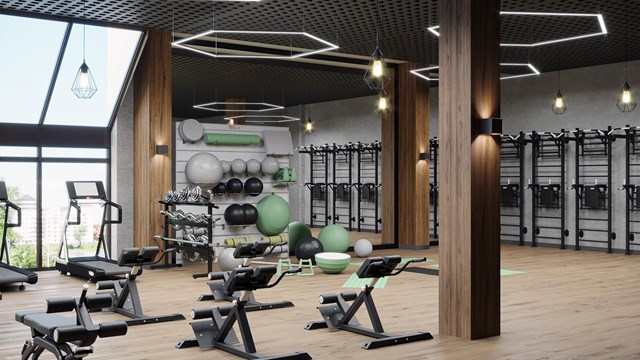Co-ops, condos and HOAs draw prospective residents with a wide variety of appealing features, from proximity to an office or family member to amazing views, to the concept of having someone else mow the lawn, fix the roof, and maintain the property. For certain residents, however, the biggest appeal of co-op and co-op living is the community of neighbors and various common spaces on the property.
“In a condo, you really don’t get a chance to interact with your neighbors,” says Marc Kotler, senior vice president of FirstService Residential, a property management company that services North America including properties throughout New Jersey. “These spaces build a sense of community and get them involved in the building. The apathy is huge…you can’t get people to run for a board, but if you build a sense of community, that might change.”
Popular Spaces
Looking back, Kotler has been in the multifamily industry since 1987, and understands how common spaces have changed over time. “Back then, common spaces were only about laundry rooms and larger storage spaces,” he says. “Today, buildings have common areas that are for grilling, golf simulators, dog wash areas, and wine cellars. Now, they really are demographic and user-specific areas.”
In his experience, these spaces are popular among residents. “Especially in one building—where the units are typically smaller spaces—the residents will use the common areas as a form of a living room,” he says. “There are long conference tables in the rooms, and the residents will bring their laptops and work from there. Also, you’ll see a population of children watching television with their mothers and nannies.”
However, the line “If you build it, they will come” may have worked for Kevin Costner's character in Field of Dreams, but it doesn’t always work for a condo or co-op. Simply having a common space for residents to use—whether it be a fancy wine cellar or a simple conference room—doesn’t automatically entice them to leave their units and gather together.
“In our buildings, the grill and barbecue areas are always a focal point as they offer a social outlet for residents who would like to meet and spend time with their neighbors,” says Tyler Kalian, an assistant project manager with Toll City Living, based in Hoboken. “The movie theater areas that we have are a big hit…they can be reserved to view sports games and other television events.”
“The most popular common spaces I deal with are the clubhouse and pool,” adds Harry Fischer, the president of Executive Quality Property Management, a management firm based in Marlboro. “Those places are a social hub in most communities. It’s where residents meet and have their parties or their monthly meetings; it’s a social center.”
Technically, boards are not under any obligations to do anything with common areas, but many buildings have created screening rooms, wine storage areas, and play areas for children. Fitness centers are still popular common spaces, but now rooms are more for multi-use and come with a lounge, dining room, and large-screen TVs. With a little creativity, common spaces can bring residents together, but how these spaces are actually utilized depends on the individual community.
“A few of our common rooms are used for bridge or bingo, it also serves as a meeting room for clubs; the crafts club or the ladies club. Some of the clubhouses have a game room…sometimes with a card table,” says Fischer. “Most clubhouses have too little space, but all of these rooms are getting used in one way or another.
Kotler says the best way to generate resident interest in the common rooms is to schedule regular programming. “You can bring in a local vendor to do a wine tasting one month, and then have a local restaurant do a cooking demonstration,” he says. “In most cases, these programs are free and build that sense of community.”
A simple Internet search can provide other programming ideas for events, from psychic readings to performances by comedians and piano recitals to book readings by professional authors.
Get With The Porgram
Also, there are companies—such as Well Beyond 55—that can assist the board in providing unique programming to the residents. The companies provide free lectures on health and legal topics, but are not allowed to solicit residents.
Keeping up with the Joneses, or—in this case—where the Joneses live, isn’t only about showing off the building’s latest (and maybe greatest common) spaces to the residents, hoping they will come and use it to meet their neighbors. In fact, the common spaces can improve a building’s bottom line.
While many programs are free, others require admission fees, which can generate revenue. Also, often, a successful common area gets residents talking about how much they enjoy the building. Word-of-mouth generates interest from other potential buyers who want to enjoy the same amenities.
If the board wants residents to use a space, the members may have to consider a remodel if the current space leaves a little more to be desired. A few years ago, The Solomon Organization—with properties in New York and New Jersey—converted one of the common spaces in a Lancaster, Pennsylvania property from an underutilized and outdated clubhouse into the social center of the community.
They renovated the property to include a fitness center, game room, media room with HDTV's and Wi-Fi access for all tenants, and lounge area with a kitchen that could be rented out for parties.
“Areas where residents can seamlessly congregate and socialize—such as large tables for shared seating—is a must have for any common space,” says Kalian. “These setups enhance the sense of community amongst a group of people who already share the commonality of choosing to live in the same area and building.”
“All of my buildings have a kitchen area so that when they have parties they can prepare and stage food,” says Fischer. “The common areas also have Wi-Fi because, today, people will have computers and smart phones and so forth, and they need to be able to communicate. It’s also a good idea to have couches and chairs in common areas. A library is a good idea for a common area…everyone can contribute voluntarily, and residents can have a nice place to read.”
Even buildings with the biggest, flashiest, and fanciest common rooms and programming sometimes struggle with getting residents away from their computers, televisions, and couches. While it’s not required, a sense of community can turn a simple building into a home where residents tell others how much they love living there.
“Common rooms are important, in terms of providing a social space where people can meet and get to know one another and form a community, because without a common space, people don’t really get to know one another,” says Fischer. “I live in a community that doesn’t have a common space, and I don’t know who my neighbors are. A common area is where everybody goes to meet everyone…and that’s a good purpose.”
Lisa Iannucci is a freelance writer and a frequent contributor to The New Jersey Cooperator. Staff writer Christy Smith-Sloman contributed to this article.







Leave a Comment